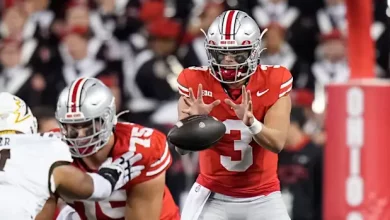Breaking down the mechanics behind Duke’s defensive dominance

Duke University’s men’s basketball program, under the leadership of Jon Scheyer, has continued to uphold a reputation for defensive excellence in college basketball. The Blue Devils have long been recognized for their ability to lock down opponents with tenacious defense, a tradition that has been passed down from the legendary Mike Krzyzewski era. In the 2024 season, Duke’s defense has been a cornerstone of their success, with their ability to stifle opposing offenses making them one of the most difficult teams to score against. This article will break down the mechanics behind Duke’s defensive dominance, focusing on their defensive strategies, key players, and statistical advantages that contribute to their ability to neutralize high-powered offenses.
Defensive Philosophy: A Foundation Built on Aggression and Discipline
At the heart of Duke’s defensive approach is a philosophy that blends aggression and discipline. The Blue Devils don’t simply rely on individual talent but emphasize teamwork, awareness, and commitment to defensive fundamentals. The ability to pressure the ball, contest shots, and limit second-chance opportunities all play key roles in Duke’s defensive identity.
1. On-Ball Pressure: Disrupting Offensive Flow
One of the most significant aspects of Duke’s defense is their on-ball pressure. The Blue Devils pride themselves on staying in front of their man and disrupting the rhythm of opposing ball handlers. Their guards, notably Tyrese Proctor and Jeremy Roach, play a critical role in this aspect of the defense, utilizing quickness and anticipation to challenge ball handlers and force difficult decisions. The defensive strategy is designed to put constant pressure on the opposing team’s offensive flow, forcing them out of their comfort zone.
On-ball pressure is particularly effective when paired with the team’s help defense principles. Duke’s defenders have a strong understanding of when to pressure their assignment and when to force the ball toward help, ensuring that even if a player gets beaten, there’s always a second line of defense ready to contain the drive.
2. Team Defense: The Importance of Rotations and Help
While Duke’s individual defenders are skilled, their defensive success stems largely from their cohesive team defense. The Blue Devils emphasize strong rotations and help defense, allowing them to protect the rim and contest outside shots with precision. When one defender is beaten, others are quick to rotate, ensuring that the offensive player has limited options to exploit. This “next-man-up” mentality enables Duke to remain flexible and cover for each other’s mistakes without breaking down.
Duke excels in the “tagging” system, where players make quick decisions on switching, helping, and recovering to their assigned man. A perfect example of this system in action is their ability to close out on shooters effectively. The Blue Devils have a knack for closing out with high hands, ensuring that shooters are forced to take contested shots. Additionally, their ability to rotate on fast breaks and recover to their assignments quickly is a testament to their discipline and awareness on the defensive end.
3. Communication: The Backbone of Defensive Cohesion
A crucial component of Duke’s defensive system is communication. The Blue Devils are constantly talking to each other on the floor, calling out screens, switches, and rotations. This vocal leadership ensures that everyone is on the same page and that defensive lapses are minimized. The defense is organized, and players know exactly when to help, when to switch, and when to stick to their assignment. This level of communication prevents breakdowns, allowing Duke to operate as a well-oiled defensive machine.
The leadership of veteran players like Jeremy Roach has been pivotal in fostering this culture of communication. Roach is a vocal presence on the floor, helping to direct traffic and ensure that his teammates are in the right positions. His defensive awareness and leadership abilities set the tone for the entire team, as Duke’s defense is as much about execution as it is about unity.
Key Personnel: Players Who Drive Defensive Success
While Duke’s defensive scheme is effective, it is their players who bring it to life. The Blue Devils boast a roster of skilled defenders who excel in different areas, from on-ball pressure to rim protection. These individuals make the system even more potent, each contributing their unique talents to ensure that Duke remains a defensive juggernaut.
1. Cooper Flagg: A Defensive Game-Changer
Freshman phenom Cooper Flagg has quickly established himself as one of the most elite defenders in college basketball. Standing at 6’9” with an incredible wingspan, Flagg’s ability to affect both the perimeter and the paint makes him a two-way force. His versatility allows him to guard multiple positions, from forwards to guards, giving Duke the flexibility to switch on screens and adapt to different offensive threats. Flagg’s ability to protect the rim is particularly noteworthy—his shot-blocking timing and discipline allow him to contest shots without fouling, providing an additional layer of protection for Duke’s defense.
What sets Flagg apart is his basketball IQ. He is always in the right position to help on drives and rotations, and his ability to anticipate passes makes him a disruptive force in the passing lanes. His defensive presence has been a catalyst for Duke, elevating their defense to another level.
2. Kyle Filipowski: Defensive Versatility and Rebounding
Kyle Filipowski, a sophomore forward, is another key contributor to Duke’s defensive success. His ability to guard multiple positions, from the post to the perimeter, makes him one of the most versatile defenders on the team. Filipowski has the strength to battle inside against bigger players but also the lateral quickness to keep up with smaller, quicker guards on switches. His understanding of defensive principles—such as positioning and help defense—has been instrumental in Duke’s ability to limit scoring opportunities.
Additionally, Filipowski’s rebounding prowess is crucial to Duke’s defensive success. His ability to secure defensive boards not only prevents second-chance points but also ignites Duke’s transition offense. Filipowski’s work on the glass, combined with his ability to switch defensively, makes him a key piece of the Blue Devils’ defense.
3. Jeremy Roach: The Veteran Leader
Senior guard Jeremy Roach’s experience and leadership are invaluable to Duke’s defense. Roach is known for his ability to disrupt opposing ball handlers with his quickness, anticipation, and active hands. His perimeter defense has been a key factor in forcing turnovers and disrupting offensive rhythm. Roach excels at guarding point guards and is often tasked with limiting the opposing team’s best playmaker.
What sets Roach apart, however, is his ability to defend in the clutch. In critical moments, Roach’s defensive tenacity and leadership come to the forefront, making him an indispensable asset in Duke’s defensive system. His leadership extends beyond individual defense—he also helps organize Duke’s help defense and ensures that the team remains connected throughout possessions.
4. Mark Mitchell: Wing Defense and Versatility
Mark Mitchell, a forward who has been a standout on both ends of the floor, brings a unique skill set to Duke’s defense. Mitchell’s length and athleticism make him a formidable defender, especially on the wings. His ability to guard larger forwards while also defending on the perimeter allows Duke to switch effortlessly between man-to-man and zone defense. Mitchell’s active hands and anticipation also help him create turnovers, further disrupting the flow of opposing offenses.
Mitchell’s defensive versatility is key for Duke, allowing the Blue Devils to adjust their defensive strategy based on the opponent’s personnel. Whether defending the ball on the perimeter or contesting shots in the paint, Mitchell is a player who can fill multiple defensive roles.
Defensive Schemes: Adapting to Opponents
Duke’s defense is not static. The Blue Devils frequently adjust their defensive strategies based on the opponent’s strengths, which is a testament to their coaching staff’s ability to adapt. Duke is known for switching between man-to-man and zone defenses, depending on the situation and the matchups.
1. Man-to-Man Defense: Sticking to Fundamentals
Duke’s primary defense is man-to-man, a system that emphasizes tight ball pressure, staying in front of offensive players, and constant communication. This defense requires players to be active on the ball and always aware of their surroundings. The Blue Devils do an exceptional job of fighting through screens, contesting shots, and avoiding easy looks.
A key feature of Duke’s man-to-man defense is the team’s ability to switch on screens without losing their defensive assignments. The versatility of players like Cooper Flagg, Kyle Filipowski, and Mark Mitchell allows the Blue Devils to adapt their defense on the fly, ensuring that they can handle both on-ball screens and off-ball movement without losing the integrity of their defense.
2. Zone Defense: Mixing It Up
Duke occasionally employs a 2-3 zone defense, especially against teams with high-scoring shooters. The zone helps clog the middle, forcing opponents to settle for outside shots or drive into a crowded paint. Duke’s length and athleticism allow them to cover ground quickly and contest shots, making it difficult for opponents to exploit the zone.
The zone defense also gives Duke an opportunity to pressure the ball and create turnovers. If the opposing team struggles to shoot from the outside, Duke can effectively trap the ball and force errant passes, which can lead to fast-break opportunities.
Statistical Analysis: Duke’s Defensive Metrics
Duke’s defensive dominance is evident in the statistical metrics that define their success. As of the 2024 season, Duke ranks near the top in several key defensive categories:
- Points Allowed Per Game: Duke consistently holds opponents to under 60 points per game, a testament to their ability to stifle offenses and force tough shots.
- Field Goal Percentage Defense: The Blue Devils rank among the top teams in the country in field goal percentage defense, allowing opponents to shoot below 40% on average.
- Turnovers Forced: Duke’s aggressive on-ball defense and ability to disrupt passing lanes result in high turnover numbers, creating additional opportunities for fast breaks and transition points.
- Rebounding: Duke’s dominant rebounding performance ensures that opponents are not given second chances. Their ability to secure defensive boards and limit offensive rebounds is a crucial factor in their defensive efficiency.
The Blueprint for Defensive Success
Duke’s defensive dominance in 2024 is the result of a combination of aggressive on-ball defense, team-oriented help defense, strong communication, and individual talent. The Blue Devils excel in their ability to adapt to various offensive threats while maintaining their core defensive principles. The contributions of players like Cooper Flagg, Kyle Filipowski, and Jeremy Roach ensure that Duke’s defense remains one of the most feared units in college basketball.
The mechanics of Duke’s defense—pressure, rotations, and communication—are what make it so effective. By blending individual talent with a team-first mentality, the Blue Devils have created a defensive juggernaut that can stifle any opponent. As the season progresses, Duke’s defense will remain a key factor in their pursuit of championship glory, ensuring that they are one of the most well-rounded and dominant teams in the country.









